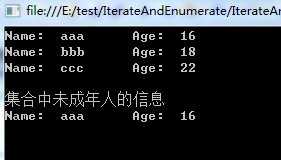标签:
http://www.cnblogs.com/zouzf/archive/2012/02/22/2362954.html
本人初学C#,本文仅供个人整理思路用,那里说得不对,请大家多多指教,万分感激!
上一篇文章为自定义类实现了foreach的功能,但实现过程中要实现IEnumerator接口(包括MoveNext、Reset函数和Current属性)以便GetEnumerator函数能获取枚举数,有点复杂,有点繁琐。
已经知道:主要一个类实现了GetEnumerator函数就能foreach,而实现IEnumerator接口只是实现GetEnumerator函数的其中一个办法,也就说还有其他办法实现GetEnumerator函数了?是的,C#2.0为我们提供了一种很简单的方法来实现GetEnumerator函数,那就是使用迭代器!(还记得吧,C#里的迭代器和C++里的是不同的)
下面是来自MSDN的解说:
迭代器概述
迭代器是可以返回相同类型的值的有序序列的一段代码。
迭代器可用作方法、运算符或 get 访问器的代码体。
迭代器代码使用 yield return 语句依次返回每个元素。yield break 将终止迭代。有关更多信息,请参见 yield。
可以在类中实现多个迭代器。每个迭代器都必须像任何类成员一样有唯一的名称,并且可以在 foreach 语句中被客户端代码调用,如下所示:foreach(int x in SampleClass.Iterator2){}
迭代器的返回类型必须为 IEnumerable、IEnumerator、IEnumerable<T> 或 IEnumerator<T>。
yield 关键字用于指定返回的值。到达 yield return 语句时,会保存当前位置。下次调用迭代器时将从此位置重新开始执行。
第一部分:使用默认迭代器实现获取枚举数
1、定义Person类
复制代码
1 public class Person
2 {
3 public string Name;
4 public int Age;
5
6 public Person(string name, int age)
7 {
8 Name = name;
9 Age = age;
10 }
11
12 public override string ToString()
13 {
14 return "Name: " + Name + "\tAge: " + Age;
15 }
16 }
复制代码
2、定义PeopleEnum1类,里面实现了GetEnumerator函数(也就是迭代器了,这是默认的迭代器),但实现的过程相对于上一篇文章里介绍的实现过程要简单很多,这就是yield的功效。yield的实现原理这里就不详说了,可以概括为:GetEnumerator函数里的迭代块把 IEnumerator接口的MoveNext、Reset方法和Current属性封装了,但本质没变,只是我们使用起来更方便了。
复制代码
1 public class PeopleEnum1
2 {
3 private Person[] _perple;
4
5 //构造函数
6 public PeopleEnum1(Person[] list)
7 {
8 _perple = new Person[list.Length];
9 for (int i = 0; i < list.Length; i++)
10 {
11 _perple[i] = list[i];
12 }
13 }
14
15 public IEnumerator GetEnumerator()
16 {
17 for (int i = 0; i < _perple.Length; i++)
18 {
19 yield return _perple[i];
20 }
21 }
22
23 }
复制代码
3、主函数代码
复制代码
1 class Program
2 {
3 static void Main(string[] args)
4 {
5 Person[] persons = new Person[]
6 {
7 new Person("aaa", 20),
8 new Person("bbb", 21),
9 new Person("ccc", 22)
10 };
11
12 PeopleEnum1 peopleEnum = new PeopleEnum1(persons);
13
14 foreach (var item in peopleEnum)
15 {
16 System.Console.WriteLine(item);
17
18 }
19
20 System.Console.ReadKey();
21 }
22 }
复制代码
运行,成功,嘿嘿
第二部分:自定义迭代器
第一部分用默认迭代器GetEnumerator 实现了类的foreach,我们也可以定义自己的迭代器来获取自己想要的枚举数。比较说,我想列举出类中未成年人的信息,默认的迭代器无能为力,该怎么实现自定义的迭代器呢?
1、为PeopleEnum1类添加一个迭代器 GetChildren ,在这里,这个迭代器是一个属性,也可以定义为函数。对于类中的元素,只有Age 小于18的元素才 yield return ,其他的不要。
复制代码
1 public class PeopleEnum1
2 {
3 private Person[] _perple;
4
5 //构造函数
6 public PeopleEnum1(Person[] list)
7 {
8 _perple = new Person[list.Length];
9 for (int i = 0; i < list.Length; i++)
10 {
11 _perple[i] = list[i];
12 }
13 }
14
15 //默认的迭代器?
16 public IEnumerator GetEnumerator()
17 {
18 for (int i = 0; i < _perple.Length; i++)
19 {
20 yield return _perple[i];
21 }
22 }
23
24
25 //自定义迭代器
26 public IEnumerable GetChildren
27 {
28 get
29 {
30 for (int i = 0; i < _perple.Length; i++)
31 {
32 if (_perple[i].Age < 18)
33 {
34 yield return _perple[i];
35 }
36 }
37 }
38 }
39 }
复制代码
2、主函数代码
复制代码
1 class Program
2 {
3 static void Main(string[] args)
4 {
5 Person[] persons = new Person[]
6 {
7 new Person("aaa", 16),
8 new Person("bbb", 18),
9 new Person("ccc", 22)
10 };
11
12
13 PeopleEnum1 peopleEnum = new PeopleEnum1(persons);
14
15 foreach (var item in peopleEnum)
16 {
17 System.Console.WriteLine(item);
18 }
19
20
21 Console.WriteLine("\n集合中未成年人的信息");
22
23 foreach (var item in peopleEnum.GetChildren)
24 {
25 Console.WriteLine(item);
26 }
27
28 System.Console.ReadKey();
29 }
30 }
复制代码
输出结果:
输出结果:

可以看到,自定义的迭代器 GetChildren 成功foreach了。
注意:默认迭代器 GetEnumerator 的返回类型是 IEnumerator ,并且在使用foreach时 in 后面直接是类名。而自定义迭代器 GetChildren 的返回类型是 IEnumerable,并且在使用foreach时 in 后面是 PeopleEnum.GetChildren(类名.迭代器名)。好像,好像是规定这样子的,原理是什么还不清楚。
标签:
原文地址:http://www.cnblogs.com/mimime/p/5698197.html